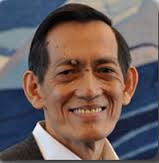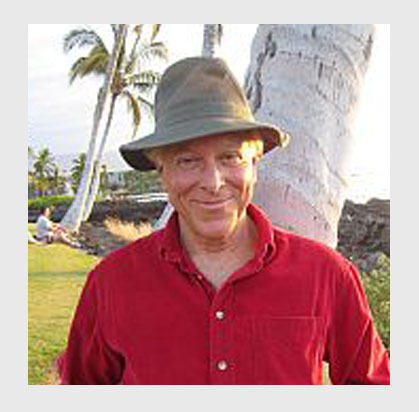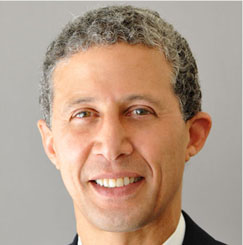The Goal of Education
Printed in the Spring 2014 issue of Quest magazine.
Citation: Chin, Vicente Hao. "The Goal of Education" Quest 102. 2 (Spring 2014): pg. 56-59
By Vicente Hao Chin
 The aim of education is to prepare young people for life. What is this life that we are preparing for?
The aim of education is to prepare young people for life. What is this life that we are preparing for?
In standard education, life is implicitly defined as social life, that is, the young students are being prepared to adapt to society. The values, habits, attitudes, and skills being inculcated are those that are approved by current society. Five centuries ago, these values would have been different.
Today's colleges, for example, devote an inordinate proportion of the curriculum to subjects that are meant to heighten skills for certain professions, such as marketing, financing, banking, or computer science. The implied message is that the aim of college education is to "succeed" in one's career. As a result, the meaning of the individual's life is frequently defined in terms of career.
This assumption"that life is to be defined in terms of professional values"is both superficial and shortsighted.
It is superficial because human life is more than professional life. It is also about relationships, joy, sorrow, meaning, love, harmony, contentment, and spirituality.
Such a view is also shortsighted because it does not consider the larger purpose of human life. Human life has a metaphysical or transcendent aspect that goes beyond the changing values of society. Because educators, philosophers, and religious people cannot agree about this purpose, this aspect has generally been relegated to a secondary place among public and secular institutions. Religious schools, on the other hand, assume such a metaphysical foundation of life but translate such a perceived larger purpose into the curriculum in a dogmatic and unhealthy manner that makes people fearful, superstitious, and sometimes irrational.
Preparation for life must embody a view that is both commonsensical and profound, based on the accumulated wisdom of humanity. Such a view must be understood and not just be blindly believed.
Here are some thoughts on what we are preparing children for:
- To be able to effectively face the challenges of the natural and social world of an adult. This includes sufficient knowledge about health, language, culture, technology, etc., as well as general knowledge that enables children to navigate the labyrinth of modern society.
- To live a generally happy and fulfilling life. This has emotional, cognitive, and ethical aspects, that is, knowing how to handle our emotional nature, as well as having a reasonably effective philosophy of life and an ethical way of living based on sound, universal moral principles.
- To have effective and fulfilling relationships. Failure in relationships is perhaps the major cause of human unhappiness.
- To be able to discover one's calling and pursue it meaningfully to the best of one's ability.
- To pursue one's highest potential in terms of human growth. This natural drive is called by many names: the drive towards maturity, self-actualization, or self-realization.
- To be able to meaningfully contribute towards the welfare and happiness of human beings, as well as of other sentient creatures in nature; to help humanity attain a state of collective harmony and mutual benevolence on an enduring basis.
An individual who is able to achieve most, if not all, of these goals would be a fulfilled human being. We can hardly ask for more. To realize these potentials is the highest goal of education.
In the light of the above, much of modern education is a failure, both in the so-called developed and in the developing countries. In the economically developed countries, we find an elevated level of stress, anxiety, alienation, and divorce, as well as high incidences of crime, drugs, and suicide. In the developing countries, there is a high degree of injustice, corruption, insecurity, inequality of income, illiteracy, and social superstition.
The goal of many progressive schools and alternative education methods is to correct the present imbalance of school curricula, as well as to provide an environment that will nurture wholesomeness of character in the individual. They avoid the many harmful methods that characterize many of our modern schools, such as competitiveness, use of grades in the measurement of competence, and the use of fear and coercion in motivating students to study.
A Preparation for Life
Formal education, then, is a systematic preparation for life in its broadest sense, rather than merely preparing for social adaptation.
An uneducated person, in this larger context, will have to find out the solutions to the puzzles and difficulties in life by trial and error, and will have to depend upon his or her native intelligence, resourcefulness, and endurance. An educated person, however, is exposed to a systematic and accelerated way in which these lessons are learned beforehand, thus lessening the chances of pain and suffering when one faces life as an adult.
Good education, therefore, is one that will prepare a person to face life in its totality, contributing to the happiness and fulfillment of the individual, whereas poor education essentially fails in this task.
Education involves at least three aspects:
Integrated understanding of life. Good education provides an adequate and balanced map of reality that addresses significant facets of life and nature that affect one's happiness and sense of meaning. At present, the general maps of reality given by schools are based on a popular understanding of life, which is characterized by serious internal contradictions. This view teaches that honesty is good but at the same time teaches that honesty is impractical. It teaches love but at the same time views genuine love as too idealistic. In the long run, this approach fails in many significant ways, both for the individual and for society. For the individual, it results in unhappiness and psychological fragmentation. For society, it leads to insecurity, destruction, conflict, and war.
Development of sound character. Dealing with life involves the development of certain qualities, such as perseverance, kindness, absence of fear, a sense of justice, and truthfulness, that harmonize one's nature with reality. Character development entails a clarity of values"about what is right and wrong, what is more important and less"and the ability to act in accordance with these values. In its loftiest levels, good education will include the nurturing of the transcendent life.
Acquiring of life skills. Life skills are capabilities that address the demands of life in current society. Certain levels of knowledge about language, computers, commerce, and politics are needed for an individual to function well in present society. Those who do not acquire such knowledge will tend to be relegated to job functions that are basic and survival-oriented and may lead to a sense of unfulfillment in life.
Generally, standard schools all over the world focus mainly on the third need"to be able to cope with the demands of society: earning a living, becoming well-informed about history and current events, acquiring current social values, etc.
This third aspect, while important, does not in itself lead to deep fulfillment in life. Success in it may provide satisfaction, but does not necessarily ensure happiness and meaningfulness. This third aspect also tends to wrap the individual in the cocoon of current social values, blind to the larger picture of what life and existence are all about.
The task of the educator, then, is to formulate a program that will meet all of these three needs. A school that merely satisfies the third need will be nurturing young people who will likely encounter insurmountable walls later when their life skills are not adequate to meet deeper issues, such as happiness, effective relationship, self-mastery, or spirituality.
Integrated Understanding
Children learn about life and its rules through exposure to, and interaction with, people and environment. Their inherent or instinctive reactions to such exposure help form their personalities. Examples of such reaction patterns are pain avoidance, curiosity, tendency to repeat pleasure, instinct for survival, fear, need for security, and need for approval.
Exposure and reaction automatically develop a worldview in the child, and this worldview is his or her understanding of what life is. It is not consciously formulated, but unconsciously formed. Thus, for instance, becoming a bully is an unconscious reaction to insecurity"the need to assert oneself through aggression in the face of perceived threats.
The child's worldview, therefore, is simply an amalgamation of distinct and disparate learned reactions to environmental situations and pressures. It has two characteristics:
The worldview is unintegrated, that is, contradictory views within it can coexist because children still have a poor capacity for integration. They do not think things through thoroughly and do not yet understand the meaning and implication of life issues.
Such a worldview is also unexamined, that is, there is a tendency to accept the statements of adults or media with little questioning, and thus perpetuate it even if it leads to dysfunctionality.
Schools tend to perpetuate this lack of integration as well as a failure to review the validity of popular worldviews. This is due to a number of factors.
The adults themselves (teachers and administrators) harbor the same contradictory elements in their own lives and worldviews so that they do not consider these as unusual or abnormal. Thus the contradiction between "Honesty is the best policy" and "Honesty is often impractical" is left unresolved. The contradiction between the virtue of love and the justifications for anger is left unresolved. That God is omniscient does not appear to them as inconsistent with the Old Testament teachings that God regrets having done something or that God changes his mind when someone prays to him.
The ability to review or question the validity of a statement or a presumed fact is a sign of intelligence. The standard school system often does not encourage this because it is too troublesome to have to explain everything to students. Besides, many teachers often do not know the answers, and get irritated when they are asked questions they cannot answer. They often resort to the power of their authority to inhibit such questioning. A typical teacher would get irritated if asked, "Why do I have to study how to solve square roots?" or "Why do we have to memorize the capital cities of the provinces?"
It is easier to require children to do a certain assignment than to motivate them to do the assignment.
For this reason it is important for a school to have teachers who are psychologically active, creative, and free. They themselves are not afraid to question things and hence tend to integrate their own understanding of life. They are willing to reject beliefs that are inconsistent with validated views of life. This necessarily means that the administrators or heads of schools should similarly be open, creative, and free, and do not feel threatened when assumptions are questioned by teachers, students, and parents. These all bring us to the issue of the education of the educators themselves, that is, the universities that prepare them to become teachers and administrators. These institutions themselves often embody unintegrated views of living, thus producing unintegrated educators. We find ourselves in a chicken-or-egg dilemma. This is where truly progressive schools become important; they are willing and ready to break this pernicious cycle and start with solid foundations.
Character Building
The ability to face the challenges of life entails the development of certain character qualities, such as one-pointedness, self-mastery, absence of fear, respectfulness, and friendliness. It also entails clarity in one's ethical views and a willingness to practice them in life.
The home and school environments are the primary training grounds for character. This is not so much taught as learned from example. Again, this is difficult to teach, primarily because many parents and teachers have not sufficiently developed these character qualities within themselves. It is difficult to teach integrity if parents or teachers have problems in making their actions consistent with their teachings.
But at the same time character building can be systematically taught, provided that the teachers are clear bout values and principles as well as the methods of inculcating such values, and provided that they themselves are genuinely trying to arrive at such integration. For example, a child who is psychologically secure does not become a bully, because there is no psychological motivation for bullying if the teachers and the school environment consciously endeavor to be affirming and supportive. Honesty can be strengthened in an environment that does not penalize honesty.
Character development is not simply about values and virtues. It also involves a quality of self-awareness about internal psychological conflicts that need to be integrated and resolved. A virtue like love cannot manifest when a child is not aware of the uncontrollable rise of anger. When anger takes over, there is a compulsive desire to hurt others"an act that is the opposite of love.
Thus character building does not simply involve knowing about right and wrong, but also requires the self-mastery that enables one to act according to one's views or convictions (being honest, free from fear, etc.). The development of this capacity is the self-transformative aspect of education: the mastery of one's behavioral patterns and the awakening of one's higher nature. All schools must include self-transformative insights and skills into their curricula.
Learning Life Skills
Skills differ from character and worldviews. While character goals are quite universal regardless of era and culture, skills are often dependent upon culture, social convention, and the prevalent technology.
Communication skills are among the most important skills that a young person needs to develop. With character as the foundation, the ability to communicate effectively smooths the individual's relationship with others. This includes the capacity to genuinely listen and to speak assertively without hurting or offending others. An inordinately high percentage of human unhappiness is due to relationship failures. Communication skills are the second-level foundation of effective relationships and social skills. The first level, as we have seen, is character quality, for without this, communication skills become little more than a technique or a form of manipulation.
The development of intellectual ability is needed more and more as the world grows more and more complex. It is said that the volume of information in the world doubles every twenty years. To be able to appreciate the essentials of such information and use them in one's professional life has become a necessity in the modern world. A good school is one that is able to adequately prepare young people to acquire these skills such that they become effective in their chosen career or life work. But the demands for professional excellence must not stifle the deeper quest for an integrated and meaningful life. The school itself must nurture the balance between the outer and the inner, between the material or social and the psychological and spiritual. The lopsided life is the breeding ground of insecurity, competition, self-centeredness and antisocial behavior.
A wholesome school, then, must be able to prepare students to meet the demands of an adult life in terms of career, social skills, self-mastery, self-awareness, clarity of values, and an integrated philosophy of life. Without such an integral approach, schools will tend to produce dysfunctional individuals who may be competent accountants or engineers but who are dismal failures in life"unhappy, unfulfilled, and a bane to themselves and society. Right education and wise educators play a pivotal role in breaking the social cycle that perpetuates the formation of the maladapted life. They also prepare the ground for a meaningful, happy, and productive life, which forms the basis of a harmonious, benevolent, and enlightened society.
Vicente Hao Chin, Jr., is past president of the Theosophical Society in the Philippines as well as founder and president of Golden Link College. His works include Why Meditate? and The Process of Self-Transformation. This article is a revised adaptation of a chapter of his book On Education.



 Like many other spiritual groups in the world today, the Theosophical Society expends a great deal of effort in trying to harmonize the teachings and experiences of the spiritual life with contemporary science. In our times the last thing anyone wants is to be regarded as "unscientific." This pressure to kneel at the altar of science has been both a blessing and a curse in popularizing the truths about consciousness and the inner life.
Like many other spiritual groups in the world today, the Theosophical Society expends a great deal of effort in trying to harmonize the teachings and experiences of the spiritual life with contemporary science. In our times the last thing anyone wants is to be regarded as "unscientific." This pressure to kneel at the altar of science has been both a blessing and a curse in popularizing the truths about consciousness and the inner life. It seems that the more general your topic, the more likely you are to write in platitudes. Thus for this issue, I won't try to discuss education as a whole, but will limit myself to one finite arena: the state of the liberal arts, which, it is widely said, is in crisis.
It seems that the more general your topic, the more likely you are to write in platitudes. Thus for this issue, I won't try to discuss education as a whole, but will limit myself to one finite arena: the state of the liberal arts, which, it is widely said, is in crisis.